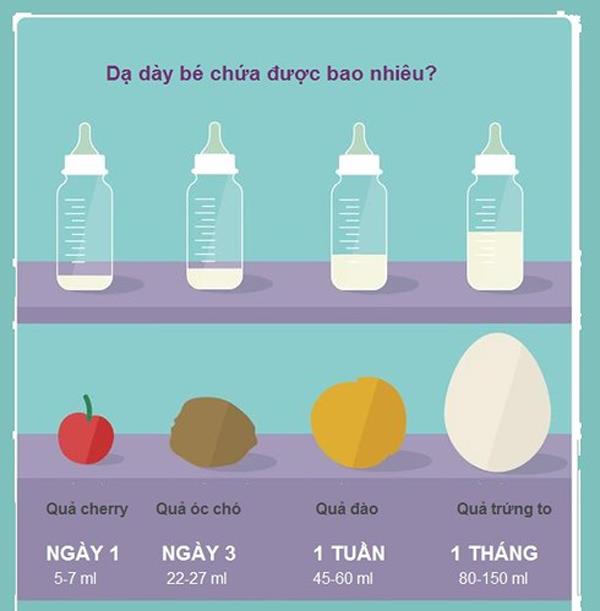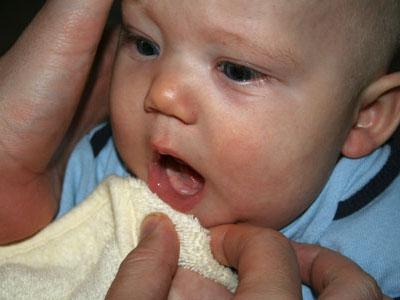The infant's stomach is horizontal, in the first days, the capacity of the stomach is only a very small amount of milk each time the baby sucks ... these basic things mom knows?
content
The infant's stomach is horizontal
How many ml does a baby's stomach hold?
Infant stomach size
Babies with gastric dilatation
It's just a story about a tiny stomach, but there are interesting facts that not everyone knows like can't shrink your stomach, stomach acid can break down metals or whether your stomach's size has nothing to do with it. body weight. Teaching babies to add more interesting things such as horizontal, increasing size by day ...
The infant's stomach is horizontal
Experts say a newborn baby's stomach is horizontal instead of vertical like an adult because the digestive system is not yet developed. The stomach in a newborn baby is horizontal and tall, the muscles are weak, the muscle spasmodic activity is not stable, so vomiting is easy.

Because the stomach is horizontal, newborn babies often vomit at first
In young children, the diastolic valve muscles (the sphincter between the esophagus and the stomach) are weak and spongy. If the baby is not feeding properly, it will cause the air in the stomach to rise with a little milk, through the mind, back up the esophagus and out. The irregular opening and closing of the stomach also contributes to the causes of gastroesophageal reflux . So, if during the suckling process, the baby swallows gas and is then placed horizontally (flat head) or on the right side, the baby is also prone to reflux.
So when the baby's stomach is stable, switch to vertical position? As soon as the baby can walk, thick teaching will automatically switch to a vertical position and the regurgitation symptoms will also decrease.
How many ml does a baby's stomach hold?
Because of not knowing this exact information in the first few days after birth , many mothers always force their babies to breastfeed a lot because they are afraid that their babies are hungry. This is not recommended because when the baby is hungry, the baby will show itself signs of fussiness, at this time, the mother should breastfeed.
In fact, in the first day of birth, the baby's stomach can only hold 5-7ml, to the third day it can hold about 30ml. Children 1 week old stomach will store 60ml and after 1 month will contain about 150ml.
Ideally, mothers should listen to their cries to know when they are hungry and need to feed. Below is the amount of milk a newborn breastfeeds during the first month:
Child's age Amount of milk per feed
Day 1 (0-24 hours) 7ml
Day 2 (24-48 hours) 14ml
Day 3 (38-73 hours) 38ml
Day 4 (72-96 hours) 58ml
Day 7 (144-168 hours) 65ml
Week 2-365-90ml
Infant stomach size
While still in the womb, the fetus eats with the umbilical cord, receives nutrients through the umbilical cord, not from the stomach. That is why a baby's stomach is very small at birth and will increase in size over the next few days.

The baby's stomach is as tiny as a cherry on the first day of life
A baby, when born, is not bigger than a pea, it does not expand well. The amount of milk that your baby needs is exactly equal to the amount of precious new colostrum secreted by the mother. So, just give your baby a little food, no need to supplement formula and do not worry about the baby being hungry.
6 months old, baby's stomach has just grown to the size of a strawberry, not yet 60-90ml / meal.
6-11 months old with a stomach capacity 5 times smaller than an adult, can only hold an amount of food about 200-250ml (equivalent to 1 cup of rice).
Babies with gastric dilatation
In the early days, the correct way to breastfeed and the correct amount of milk will not happen to the stomach. But if the baby is feeding more than needed and the stomach size will relax. Many babies even had reflux leading to cyanosis and had to go to the emergency room.
It can often be difficult to accurately measure how much milk your baby will take after each feeding. However, there are some other ways to “watch out” whether your baby is getting enough breastfeeds:
Breasts will be soft, no longer stiff after the baby has fed
Your baby will fall asleep after a feeding and will continue to sleep for a long time after that
The baby gains weight steadily and the growth is steady
After the first month, your baby will use several diapers a day
Usually, after a full breastfeed, the baby's mood will be more relaxed and comfortable
Once the baby is full, the baby's face will turn the other direction, "ignoring" the mother's breast

How much milk do babies drink each day? How much babies breastfeed is enough of a concern among first-time mothers. To have the correct answer, mothers need to understand about the nutritional needs of babies in each stage of development.
The infant's stomach size from the first days of birth to the first one month of age is still relatively small, mothers need to pay attention to breastfeed on demand, not force to avoid dilating the stomach, causing unfortunate consequences .














